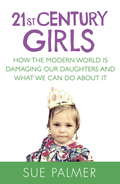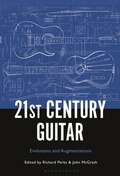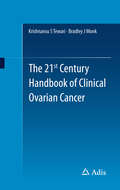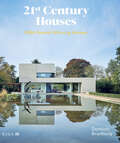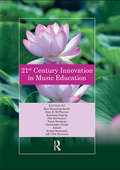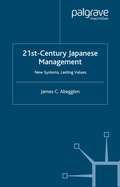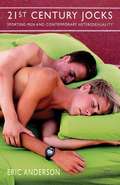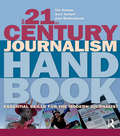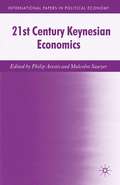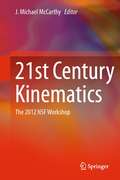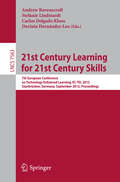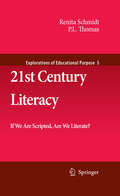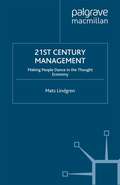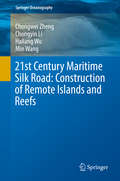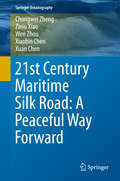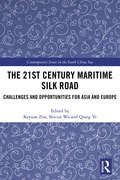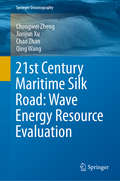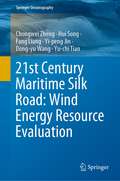- Table View
- List View
21st Century Girls: How Female Minds Develop, How to Raise Bright, Balanced Girls
by Sue PalmerAn absolute must-have parenting guide to raising girls in the 21st century.'There can be no keener revelation of a country's soul than the way it treats its children.' Nelson MandelaChildhood, as a stage in human development, has been steadily eroded. Children today are introduced to 21st-century adult values and behaviour at an increasingly early age, long before they are developmentally ready to cope with them. We expend immense time and effort attending to their material needs while simultaneously neglecting their developmental needs.In this important polemic, Sue Palmer believes that if we do not get a grip on this problem soon, the increase in developmental disorders, behavioural difficulties and mental health problems recorded by experts over recent decades will soon spiral out of control.Sue discusses challenges faced in the 21st century including:-the problems facing parents in an age of materialism-the way gender wars have intensified those problems-the debate about the 'female brain'-the reasons why contemporary culture can be so damaging for children, especially girls-the challenges involved in detoxifying family lifeEvery parent, grandparent, teacher and carer of girls needs to read this book.
21st Century Guitar: Evolutions and Augmentations
by John McGrath Richard PerksIn the 21st Century, the guitar, as both a material object and tool for artistic expression, continues to be reimagined and reinvented. From simple adaptations or modifications made by performers themselves, to custom-made instruments commissioned to fulfil specific functions, to the mass production of new lines of commercially available instruments, the extant and emergent forms of this much-loved musical instrument vary perhaps more than ever before. As guitars sporting multiple necks, a greater number of strings, and additional frets become increasingly common, so too do those with reduced registers, fewer strings, and fretless fingerboards. Furthermore, as we approach the mark of the first quarter-century, the role of technology in relation to the guitar's protean nature is proving key, from the use of external effects units to synergies with computers and AR headsets. Such wide-ranging evolutions and augmentations of the guitar reflect the advancing creative and expressive needs of the modern guitarist and offer myriad new affordances.21st Century Guitar examines the diverse physical manifestations of the guitar across the modern performative landscape through a series of essays and interviews. Academics, performers and dual-practitioners provide significant insights into the rich array of guitar-based performance practices emerging and thriving in this century, inviting a reassessment of the guitar's identity, physicality and sound-creating possibilities.
21st Century Guitar: Evolutions and Augmentations
by Richard Perks and John McGrathIn the 21st Century, the guitar, as both a material object and tool for artistic expression, continues to be reimagined and reinvented. From simple adaptations or modifications made by performers themselves, to custom-made instruments commissioned to fulfil specific functions, to the mass production of new lines of commercially available instruments, the extant and emergent forms of this much-loved musical instrument vary perhaps more than ever before. As guitars sporting multiple necks, a greater number of strings, and additional frets become increasingly common, so too do those with reduced registers, fewer strings, and fretless fingerboards. Furthermore, as we approach the mark of the first quarter-century, the role of technology in relation to the guitar's protean nature is proving key, from the use of external effects units to synergies with computers and AR headsets. Such wide-ranging evolutions and augmentations of the guitar reflect the advancing creative and expressive needs of the modern guitarist and offer myriad new affordances.21st Century Guitar examines the diverse physical manifestations of the guitar across the modern performative landscape through a series of essays and interviews. Academics, performers and dual-practitioners provide significant insights into the rich array of guitar-based performance practices emerging and thriving in this century, inviting a reassessment of the guitar's identity, physicality and sound-creating possibilities.
The 21st Century Handbook of Clinical Ovarian Cancer
by Krishnansu S Tewari Bradley J MonkA thorough review on ovarian cancer, treatment guidelines and emerging therapies available for the disease. The book was originally commissioned due to recent developments in therapies for ovarian cancer. This concise pocket book will review ovarian cancer’s epidemiology, clinical features, diagnosis and medical management. Busy healthcare professionals will benefit from this text, which will not only cover the foundation of ovarian cancer management, but discuss up-to-date national and international treatment guidelines and upcoming therapies.
21st Century Houses: RIBA Award-Winning Homes
by Dominic BradburyMany people dream of commissioning an architect to design their perfect home. It is a commitment that takes time and money, but having a bespoke space built around your specific needs, interests and desires can be life-changing. So, what makes an award-winning, 21st-century house? The Royal Institute of British Architects (RIBA) has been championing outstanding work for over 180 years, and the internationally recognised RIBA awards celebrate the very best in British architecture. The winning houses, featured here, showcase truly innovative design, contemporary materials and techniques, and inspired responses to historical and urban settings, as well as areas of natural beauty. By working closely with clients every step of the way, the architects’ extraordinary buildings redefine what ‘home’ looks like. This compilation of some of the best RIBA award-winning houses from the last ten years offers an essential source of ideas and inspiration for the contemporary British home. From a sustainable townhouse to a modern cottage, a hillside home to a lakeside escape, these houses are show-stopping examples of architects surpassing their clients’ loftiest dreams. Featuring: The best RIBA award-winning houses from the last decade Houses from each region of the UK A rich variety of projects – from new builds to conversions to extensions Case studies from esteemed practices, including: Alison Brooks Architects, Chris Dyson Architects, Foster Lomas, Henning Stummel Architects, Mole Architects and Tonkin Liu Guidance for working with architects.
21st Century Houses: RIBA Award-Winning Homes
by Dominic BradburyMany people dream of commissioning an architect to design their perfect home. It is a commitment that takes time and money, but having a bespoke space built around your specific needs, interests and desires can be life-changing. So, what makes an award-winning, 21st-century house? The Royal Institute of British Architects (RIBA) has been championing outstanding work for over 180 years, and the internationally recognised RIBA awards celebrate the very best in British architecture. The winning houses, featured here, showcase truly innovative design, contemporary materials and techniques, and inspired responses to historical and urban settings, as well as areas of natural beauty. By working closely with clients every step of the way, the architects’ extraordinary buildings redefine what ‘home’ looks like. This compilation of some of the best RIBA award-winning houses from the last ten years offers an essential source of ideas and inspiration for the contemporary British home. From a sustainable townhouse to a modern cottage, a hillside home to a lakeside escape, these houses are show-stopping examples of architects surpassing their clients’ loftiest dreams. Featuring: The best RIBA award-winning houses from the last decade Houses from each region of the UK A rich variety of projects – from new builds to conversions to extensions Case studies from esteemed practices, including: Alison Brooks Architects, Chris Dyson Architects, Foster Lomas, Henning Stummel Architects, Mole Architects and Tonkin Liu Guidance for working with architects.
The 21st Century in 100 Games (Games and Contemporary Culture)
by Aditya DeshbandhuThe 21st Century in 100 Games is an interactive public history of the contemporary world. It creates a ludological retelling of the 21st century through 100 games that were announced, launched, and played from the turn of the century. The book analyzes them and then uses the games as a means of entry to examine both key events in the 21st century and the evolution of the gaming industry. Adopting a tri-pronged perspective — the reviewer, the academic, and an industry observer — it studies games as ludo-narratological artefacts and resituates games in a societal context by examining how they affect and are engaged with by players, reviewers, the gaming community, and the larger gaming industry.This book will be a must read for readers interested in video games, new media, digital culture (s), culture studies, and history.
The 21st Century in 100 Games (Games and Contemporary Culture)
by Aditya DeshbandhuThe 21st Century in 100 Games is an interactive public history of the contemporary world. It creates a ludological retelling of the 21st century through 100 games that were announced, launched, and played from the turn of the century. The book analyzes them and then uses the games as a means of entry to examine both key events in the 21st century and the evolution of the gaming industry. Adopting a tri-pronged perspective — the reviewer, the academic, and an industry observer — it studies games as ludo-narratological artefacts and resituates games in a societal context by examining how they affect and are engaged with by players, reviewers, the gaming community, and the larger gaming industry.This book will be a must read for readers interested in video games, new media, digital culture (s), culture studies, and history.
The 21st Century Industrial Robot: When Tools Become Collaborators (Intelligent Systems, Control and Automation: Science and Engineering #81)
by Maria Isabel Aldinhas Ferreira Sarah R. FletcherThis book aims to discuss the technical and ethical challenges posed by the present technological framework and to highlight the fundamental role played by human-centred design and human factors in the definition of robotic architectures for human–robot collaboration.The book gives an updated overview of the most recent robotic technology, conceived and designed to collaborate with human beings in industrial working scenarios. The technological development of robotics over the last years and the fast evolution of AI, machine learning and IoT have paved the way for applications that extend far beyond the typical use of robots performing repetitive tasks in exclusive spaces. In this new technological paradigm that is expected to drive the robotics market in the coming years, robots and workers will coexist in the same workplace, sharing not only this lived space, but also the roles and functions inherent to a process of production, merging the benefits of automated and manual performing. However, having robots cooperating in real time with workers, responding in a physical, psychological and social adequate way, requires a human-centred design that not only calls for high safety standards regulating the quality of human–robot interaction, but also demands the robot's fine-grained perception and awareness of the dynamics of its surrounding environment, namely the behaviours of their human peers—their expected actions/responses—fostering the necessary collaborative efforts towards the accomplishment of the tasks to be executed.
21st Century Innovation in Music Education: Proceedings of the 1st International Conference of the Music Education Community (INTERCOME 2018), October 25-26, 2018, Yogyakarta, Indonesia
by Kun Setyaning Astuti Gary McPherson Bambang Sugeng Nila Kurniasari Tutut Herawan Christopher Drake Ashadi Endah Retnowati Adi Cilik PierewanMusic is an expression of feelings of the soul conveyed through the medium of sound. But not all sounds are music. It might be said that only an organised sound or series of sounds can be called music. Thus, music is connected to the eternal and constant flow and order of the universe, to the laws and rhythms of nature. It can also be said that musical order is comparable to the natural order of the universe. There are laws of a certain nature in the natural sciences and likewise in music there are structures and procedures, or even rules, that should be followed to produce beautiful music. The International Conference "Innovations for 21st Century Music Education and Research" provided a timely opportunity to take stock of the latest developments in music education and brought together educators, researchers and members of the broader community in a welcoming forum in which they were able to express theoretical and practical views, concepts, research results and principles to help support the further development of music education.
21st-Century Japanese Management: New Systems, Lasting Values
by J. AbegglenJapan's economy and businesses are entering this century with new management systems but their values unchanged. Drawing on the author's analysis of the 1950s, financial systems, personnel management methods, role of the corporation and R&D capabilities are re-assessed to provide a comprehensive analysis of Japan's financial and industrial changes.
21st Century Jocks: Sporting Men And Contemporary Heterosexuality
by E. AndersonDrawing on hundreds of interviews with 15-22 year old straight and gay male athletes in both the United States and the United Kingdom, this book explores how jocks have redefined heterosexuality, and no longer fear being thought gay for behaviors that constrained men of the previous generation.
The 21st Century Journalism Handbook: Essential Skills for the Modern Journalist
by Tim Holmes Sara Hadwin Glyn MottersheadSet against the background of the fundamental issues facing the industry today, The 21st Century Journalism Handbook is a comprehensive guide to the core principles and practices essential to the modern journalist.? Convergence, online, the growth of magazine formats, challenges presented by technology and new demands in news and feature writing are all covered from conceptual and practical perspectives. A thorough grounding in the key debates and techniques is provided; while clear, no-nonsense practical advice helps you develop your journalism skills and make a success of your studies and career. ? Key Features: A combination of professional insight, academic study and practical exercises allows?you to develop at?your own pace Thinking it through activities at the end of each chapter allow you to think over the topics discussed and to think about how you?could apply these skills Case studies and Closer Look boxes explore real-life examples in more depth Key points to remember and chapter summaries highlight the essential things you need to know Comprehensive but digestible coverage of the key elements of ethics, regulation and law ensures you are fully equipped with the essential frameworks for informed practice With an emphasis on developing the ‘whole journalist’, a creative and visual reporter who can think across different platforms, this text is ideal for all for journalism students training in newspapers, magazines and online reporting.
The 21st Century Journalism Handbook: Essential Skills for the Modern Journalist
by Tim Holmes Sara Hadwin Glyn MottersheadSet against the background of the fundamental issues facing the industry today, The 21st Century Journalism Handbook is a comprehensive guide to the core principles and practices essential to the modern journalist.? Convergence, online, the growth of magazine formats, challenges presented by technology and new demands in news and feature writing are all covered from conceptual and practical perspectives. A thorough grounding in the key debates and techniques is provided; while clear, no-nonsense practical advice helps you develop your journalism skills and make a success of your studies and career. ? Key Features: A combination of professional insight, academic study and practical exercises allows?you to develop at?your own pace Thinking it through activities at the end of each chapter allow you to think over the topics discussed and to think about how you?could apply these skills Case studies and Closer Look boxes explore real-life examples in more depth Key points to remember and chapter summaries highlight the essential things you need to know Comprehensive but digestible coverage of the key elements of ethics, regulation and law ensures you are fully equipped with the essential frameworks for informed practice With an emphasis on developing the ‘whole journalist’, a creative and visual reporter who can think across different platforms, this text is ideal for all for journalism students training in newspapers, magazines and online reporting.
21st Century Keynesian Economics (International Papers in Political Economy)
by Malcolm Sawyer P. ArestisThe current global financial and economic crisis has called for the revival of Keynesian theory. This sixth volume in the International Papers in Political Economy (IPPE) series focuses on twenty first century Keynesian economics in terms of both theory and application.
21st Century Kinematics: The 2012 NSF Workshop
by J. Michael McCarthy21st Century Kinematics focuses on algebraic problems in the analysis and synthesis of mechanisms and robots, compliant mechanisms, cable-driven systems and protein kinematics. The specialist contributors provide the background for a series of presentations at the 2012 NSF Workshop. The text shows how the analysis and design of innovative mechanical systems yield increasingly complex systems of polynomials, characteristic of those systems. In doing so, it takes advantage of increasingly sophisticated computational tools developed for numerical algebraic geometry and demonstrates the now routine derivation of polynomial systems dwarfing the landmark problems of even the recent past. The 21st Century Kinematics workshop echoes the NSF-supported 1963 Yale Mechanisms Teachers Conference that taught a generation of university educators the fundamental principles of kinematic theory. As such these proceedings will provide admirable supporting theory for a graduate course in modern kinematics and should be of considerable interest to researchers in mechanical design, robotics or protein kinematics or who have a broader interest in algebraic geometry and its applications.
21st Century Learning for 21st Century Skills: 7th European Conference on Technology Enhanced Learning, EC-TEL 2012, Saarbrücken, Germany, September 18-21, 2012, Proceedings (Lecture Notes in Computer Science #7563)
by Andrew Ravenscroft Stefanie Lindstaedt Carlos Delgado Kloos Davinia Hernández-LeoThis book constitutes the refereed proceedings of the 7th European Conference on Technology Enhanced Learning, EC-TEL 2012, held in Saarbrücken, Germany, in September 2012. The 26 revised full papers presented were carefully reviewed and selected from 130 submissions. The book also includes 12 short papers, 16 demonstration papers, 11 poster papers, and 1 invited paper. Specifically, the programme and organizing structure was formed through the themes: mobile learning and context; serious and educational games; collaborative learning; organisational and workplace learning; learning analytics and retrieval; personalised and adaptive learning; learning environments; academic learning and context; and, learning facilitation by semantic means.
21st Century Literacy: If We Are Scripted, Are We Literate? (Explorations of Educational Purpose #5)
by Renita Schmidt Paul Lee ThomasRenita Schmidt and P. L. Thomas The guiding mission of the teacher education program in the university where we teach is to create teachers who are scholars and leaders. While the intent of that mission is basically sound in theory—we instill the idea that teachers at all levels are professionals, always learning and growing in knowledge—that theory, that philosophical underpinning does not insure that the students who complete our program are confident about the act or performance of teaching. In our unique program, students work closely with one teacher and classroom for the entire senior year and then are supervised and mentored during their first semester of teaching; the program is heavily field-based, and it depends on the effectiveness of mentoring throughout the methods coursework and the first semester of full-time teaching. Students tell us this guidance and support is invaluable, and yet we feel the disjuncture between university and school just as many of you in more traditional student teaching settings. Students hear “best practice” information from us in methods classes and they receive ample exposure to the research supporting our field, but have a hard time implementing research-based practices in their cla- room settings and an even harder time finding it in the classrooms around them.
21st Century Management: Leadership and Innovation in the Thought Economy (Palgrave Studies In European Union Politics Ser.)
by M. LindgrenExplores the changing business landscape of the 21st century and what it means for organizations. The author presents a new model for how to think about and handle the complex world of business from a managerial and innovative perspective with tips and tools for motivating and engaging your organization, clients and customers.
21st Century Maritime Silk Road: Construction of Remote Islands and Reefs (Springer Oceanography)
by Chongwei Zheng Chongyin Li Hailang Wu Min WangThis book focuses on the construction of remote islands and reefs in the Maritime Silk Road. Firstly, it analyzes the functions, necessity and difficulties of the construction of remote islands and reefs; then provides corresponding countermeasures. According to the urgent demand of electricity and freshwater, it focus on wave and offshore wind energy evaluation of the important remote islands and reefs of the Maritime Silk Road, providing reference for the choice of location of power plants, daily operation and long term plan of wave/wind power generation. Several important key points are selected in the case study to realize their electricity and freshwater self-sufficiency and thus to improve their viability. This book also presents the marine characteristics (especially hazardous elements) under the demands of island runway construction and marine new energy development, to promote safe and efficient implementation of the remote islands and reefs construction. This book is one of the series of publications on the 21st Century Maritime Silk Road (shortened as “Maritime Silk Road”). It covers the characteristics of the marine environment and marine new energy, remote islands and reefs construction, climate change, early warning of wave disasters, legal escort, marine environment and energy big data construction, etc. contributing to the safe and efficient construction of the Maritime Silk Road. It aims to improve our knowledge of the ocean, thus to improve the capacity for marine construction, enhance the viability of remote islands and reefs, ease the energy crisis and protect the ecological environment, improve the quality of life of residents along the Maritime Silk Road, and protect the rights, interests of the countries and regions participating in the construction of the Maritime Silk Road. It will be a valuable reference for decision-makers, researchers, and marine engineers working in the related fields.
21st Century Maritime Silk Road: A Peaceful Way Forward (Springer Oceanography)
by Chongwei Zheng Ziniu Xiao Wen Zhou Xiaobin Chen Xuan ChenThis book focuses on understanding the characteristics of the marine environment; overall characteristic of the marine resources (especially the marine new energy) and their current utilization; important routes, channels, and ports; and the Maritime Silk Road from the perspective of international law. It also discusses the significance and opportunities of the Maritime Silk Road initiative, analyzes the challenges involved in the construction of the Maritime Silk Road and provides corresponding countermeasures. Based on the above research, this book also proposes to construct a comprehensive application platform for the Maritime Silk Road that will be a practical tool for decision-making. This book is one of the series publications on the 21st century Maritime Silk Road (shortened as “Maritime Silk Road”). This series publications cover the characteristics of the marine environment and marine new energy, remote islands and reefs construction, climate change, early warning of wave disasters, legal escort, marine environment and energy big data construction, etc. contributing to the safe and efficient construction of the Maritime Silk Road. It aims to improve our knowledge of the ocean, thus to improve the capacity for marine construction, enhance the viability of remote islands and reefs, ease the energy crisis and protect the ecological environment, improve the quality of life of residents along the Maritime Silk Road, and protect the rights, interests of the countries and regions participating in the construction of the Maritime Silk Road. It will be a valuable reference for decision-makers, researchers, and marine engineers working in the related fields.
The 21st Century Maritime Silk Road: Challenges and Opportunities for Asia and Europe (Contemporary Issues in the South China Sea)
by Keyuan Zou Shicun Wu Qiang YeThis book explores the opportunities and challenges that both Europe and Asia face under the framework of the 21st Century Maritime Silk Road Initiative. The 21st Century Maritime Silk Road Initiative (MSR Initiative), put forward by the Chinese government together with the Silk Road Economic Belt, reflects China’s ambition and vision to shape the global economic and political order. The first step and priority under the MSR Initiative, according to documents issued by China, is to build three ‘Blue Economic Passages’ linking China with the rest of the world at sea, two of which will connect China with Europe. This initiative, however, still faces enormous challenges of geopolitical suspicion and security risks. This book seeks to assess these risks and their causes for the cooperation between the Eurasian countries under the framework of MSR and puts forward suggestions to deal with these risks in the interdisciplinary perspectives of international relations and international law. Featuring a global team of contributors, this book will be of much interest to students of Asian politics, maritime security, international law and international relations.
The 21st Century Maritime Silk Road: Challenges and Opportunities for Asia and Europe (Contemporary Issues in the South China Sea)
by Keyuan Zou Shicun Wu Qiang YeThis book explores the opportunities and challenges that both Europe and Asia face under the framework of the 21st Century Maritime Silk Road Initiative. The 21st Century Maritime Silk Road Initiative (MSR Initiative), put forward by the Chinese government together with the Silk Road Economic Belt, reflects China’s ambition and vision to shape the global economic and political order. The first step and priority under the MSR Initiative, according to documents issued by China, is to build three ‘Blue Economic Passages’ linking China with the rest of the world at sea, two of which will connect China with Europe. This initiative, however, still faces enormous challenges of geopolitical suspicion and security risks. This book seeks to assess these risks and their causes for the cooperation between the Eurasian countries under the framework of MSR and puts forward suggestions to deal with these risks in the interdisciplinary perspectives of international relations and international law. Featuring a global team of contributors, this book will be of much interest to students of Asian politics, maritime security, international law and international relations.
21st Century Maritime Silk Road: Wave Energy Resource Evaluation (Springer Oceanography)
by Chongwei Zheng Jianjun Xu Chao Zhan Qing WangThis book focuses on the evaluation of wave energy in the Maritime Silk Road. Firstly, it compares wave energy and other main energy sources, and then discusses the various disadvantages. It also presents the current research and the difficulties of wave energy evaluation, and systematically analyzes the climatic characteristics of the wave energy, including the temporal–spatial distribution and climatic trend of a series of key factors (e.g. wave power density, availability, richness, stability, energy direction, energy storage). It then describes the design of a short-term forecasting scheme and a long-term projection scheme of wave energy suitable for the Maritime Silk Road, to serve as a plan for the daily operation and long-term development of wave energy. Further, it highlights the wave energy analysis and decision-making in the context of the remote islands and reefs, using Sri Lanka is taken as a case study. Lastly, it presents the first wave energy resource dataset for the Maritime Silk Road.This book is one of a series of publications on the 21st century Maritime Silk Road (shortened as “Maritime Silk Road”) that covers the characteristics of the marine environment and marine new energy, remote islands and reef construction, climate change, early warning of wave disasters, legal escort, marine environment and energy big data construction, contributing to the safe and efficient construction of the Maritime Silk Road. It aims to improve our knowledge of the ocean, and so improve the capacity for marine construction, enhance the viability of remote islands and reefs, ease the energy crisis and protect the ecological environment and improve the quality of life of residents along the Maritime Silk Road, as well as to protect the rights, and interests of the countries and regions participating in the construction of the Maritime Silk Road. This book is a valuable reference resource for decision-makers, researchers, and marine engineers working in the related fields.
21st Century Maritime Silk Road: Wind Energy Resource Evaluation (Springer Oceanography)
by Chongwei Zheng Hui Song Fang Liang Yi-peng Jin Dong-yu Wang Yu-chi TianThis book aims to establish a wind energy evaluation system, to provide scientific reference for site selection, daily operation and long-term planning of wind power generation, thus to make contribution to breaking the shackles of power shortage. Firstly, it presents the advantages and disadvantages of offshore wind power, then further discusses about the status quo and challenges for wind power programs along the Maritime Silk Road and offer suggestions. A wind energy evaluation system was proposed with the Maritime Silk Road as a case study, including climatic features of wind power (temporal-spatial distribution), long-term climatic trend and mechanism, short-term forecast of wind energy, mid- and long-term projection of wind energy, technology of wind energy evaluation on key point or vital region and offshore wind energy dataset construction, to provide systematic and scientific reference for wind power evaluation and utilization.This book is one of the series of publications on 21st century Maritime Silk Road (shortened as “Maritime Silk Road”). It covers the characteristics of the marine environment and marine renewable energy, remote islands and reefs construction, climate change, early warning of wave disasters, legal escort, marine environment and energy big data construction, etc., contributing to the safe and efficient construction of the Maritime Silk Road. It aims to improve our knowledge of the ocean, thus, to improve the capacity for marine construction, enhance the viability of remote islands and reefs, ease the energy crisis and protect the ecological environment, improve the quality of life of residents along the Maritime Silk Road, and protect the rights, interests of the countries and regions participating in the construction of the Maritime Silk Road. It is a valuable reference for decision-makers, researchers, and marine engineers working in the related fields.
